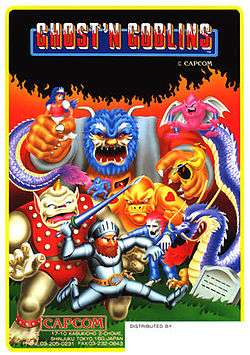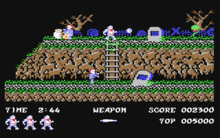Ghosts 'n Goblins (video game)
| Ghosts 'n Goblins | |
|---|---|
 Promotional arcade flyer | |
| Developer(s) | Capcom |
| Publisher(s) |
Capcom (Worldwide, Japan) Taito America (North America) |
| Designer(s) | Tokuro Fujiwara |
| Programmer(s) | Toshio Arima |
| Artist(s) | Masayoshi Kurokawa |
| Composer(s) | Ayako Mori |
| Platform(s) | Arcade, NES, PlayStation, Sega Saturn, Game Boy Color, various home computer ports |
| Release date(s) |
Arcade Commodore 64
|
| Genre(s) | Platform |
| Mode(s) | Single-player, multiplayer |
| Cabinet | Upright |
| CPU | Motorola 6809 |
| Sound | 2x Yamaha YM2203 |
| Display | Horizontally oriented |
Ghosts 'n Goblins (魔界村 Makaimura, "Demon World Village") is a 1985 side-scrolling platform video game developed by Capcom for video arcades and has since been released on several other platforms. It is the first game in the Ghosts 'n Goblins franchise.
Gameplay
Ghosts 'n Goblins is a platform game where the player controls a knight, named Sir Arthur, who must defeat zombies, ogres, demons, cyclops, dragons and other monsters in order to rescue Princess Prin Prin, who has been kidnapped by Satan, king of Demon World. Along the way the player can pick up new weapons, bonuses and extra suits of armor that can help in this task.[1]
The game is often considered very difficult by arcade standards and is commonly regarded as one of the most difficult games ever released. The player can only be hit twice before losing a life (the first hit takes away Arthur's armor, and the player must continue on in his underwear until completing the level or finding replacement armor). If the player loses a life, he is returned to the start of the level, or the halfway point if he has managed to get that far. Furthermore, each life can only last a certain length of time (generally around three minutes), the clock being reset at the start of a level. If the clock does run out, the player instantly loses that life.
After defeating the final boss, but only with the cross weapon (if the player does not have the cross weapon, they will be prompted that it is needed to defeat the boss and restart at the beginning of level 5 and must repeat round 5 and 6 again regardless of whether the weapon is obtained immediately or not) for the first time the player is informed that the battle was "a trap devised by Satan". The player must then replay the entire game on a higher difficulty level to reach the genuine final battle.
Ports
Many conversions to home computers were produced by Elite Systems.
Commodore 64

The Commodore 64 version, released in 1986, is known for its music by Mark Cooksey, which borrows from Frédéric Chopin's Prelude No. 20. Due to the limited resources on the Commodore 64, it was somewhat different from the arcade version. It only features the Graveyard and Forest, The Ice Palace, The Floating Platforms and Firebridge and The Caves in that order. The player also starts the game with five lives. The demon that kidnapped the princess replaces Astaroth in the title screen. Additionally, the cyclops (or "Unicorn") is the boss of levels one to three, and the dragon is the final boss.
Commodore 16
The version for Commodore 16/116 and Commodore Plus/4, also released in 1986 by Elite Systems, was even more limited than the C64 version. It was written to work on a Commodore 16, which had only 16 KB of RAM. Therefore, this version features only two levels and no music. In addition, the remaining two levels and the gameplay are simplified. For example, in the graveyard level, the attacking bird, the "plant monsters" and the winged demon are all missing from the C16 version, and there is only one weapon. The title screen features no graphics besides the stylised Ghosts 'n Goblins lettering.
Commodore Amiga
A version for the Commodore Amiga was released in 1990. While the advanced hardware of the Amiga allowed an almost perfect conversion of the arcade game, it failed to emulate the success of the Commodore 64 version. The player starts the game with six lives, and no music is played unless the Amiga was equipped with at least 1 megabyte of RAM. The standard configuration of an Amiga 500 had 512 kilobytes.
Famicom/NES
The Famicom version was released on June 13, 1986, and was the first Famicom game to utilize a 128 KB cartridge.[2] The North American NES version was released in November 1986. Both versions were developed by Micronics and published by Capcom.
Game Boy
The Famicom / NES ports served as the basis for the Game Boy Color version, which utilized passwords to allow the player to access certain levels. The game was also ported to the Game Boy Advance as part of Classic NES series, but only in Japan.
Virtual Console
The NES version was also re-released for download for Nintendo's Virtual Console in North America on December 10, 2007 (Wii) and October 25, 2012 (Nintendo 3DS) and in the PAL region on October 31, 2008 (Wii) and January 3, 2013 (Nintendo 3DS) while the Wii U version was released in both regions on May 30, 2013. The arcade version was released on the Wii's Virtual Console Arcade in Japan on November 16, 2010, the PAL region on January 7, 2011 and in North America on January 10, 2011.
Other platforms
Ghosts 'n Goblins was also ported to the ZX Spectrum, Amstrad CPC, MSX, Atari ST, IBM PC compatibles, Game Boy Color, Game Boy Advance.
The original arcade version of the game was also included in the compilation Capcom Generations Vol.2: Chronicles of Arthur for the PlayStation (in Japan and Europe) and Sega Saturn (in Japan only), which also contained Ghouls 'n Ghosts and Super Ghouls 'n Ghosts. The three games (based on their Capcom Generation versions) were later collected as part of Capcom Classics Collection. The game was also featured in the compilation Capcom Arcade Cabinet for the PlayStation 3 and Xbox 360.
Reception
| Reception | ||||||||||||||||||||
|---|---|---|---|---|---|---|---|---|---|---|---|---|---|---|---|---|---|---|---|---|
| ||||||||||||||||||||
| ||||||||||||||||||||
Computer Gaming World called Ghosts 'n Goblins "an excellent example of what the [NES] can do ... while hardly groundbreaking, [it] represents the kind of game that made Nintendo famous".[12]
Ghosts 'n Goblins was runner-up in the category of Arcade-Style Game of the Year at the Golden Joystick Awards.[13]
The NES version of Ghosts 'n Goblins was rated the 129th best game made on a Nintendo System in Nintendo Power's Top 200 Games list.[14] It was also a best seller for the NES, selling 1.64 million units.[15] Ghosts 'n Goblins is often cited as an example of one of the most difficult games of all time to beat, due to its extreme level of difficulty and the fact the player must play through the game twice in order to beat the game, without any way to save progress.
Sequels
Ghosts 'n Goblins was followed by a series of sequels and spin-offs eventually becoming Capcom's 8th best-selling game franchise, selling over 4.4 million units.[16] Its sequels include Ghouls 'n Ghosts, Super Ghouls 'n Ghosts, and Ultimate Ghosts 'n Goblins in addition to producing the Gargoyle's Quest and Maximo spin-off series. Though originating as an arcade title, the franchise has been featured on a variety of PC and video game consoles with the latest entries in the series, Ghosts 'n Goblins: Gold Knights, released on the iOS. Additionally, the franchise frequently makes cameo appearances—the character of Arthur in particular—in other Capcom titles, the latest of which being Ultimate Marvel vs. Capcom 3.
References
- ↑ "Ghosts 'n Goblins". The International Arcade Museum. Retrieved 5 Oct 2013.
- ↑ "Famicom Disk System (Documentary)". The Gaming Historian (YouTube). Retrieved 2016-07-14.
- ↑ Cook, Brad. "Ghosts 'n Goblins - Review". Allgame. Retrieved September 29, 2013.
- ↑ Miller, Skyler. "Ghosts 'n Goblins -Review". Allgame. Retrieved September 29, 2013.
- ↑ "Archive - Magazine viewer". World of Spectrum. Retrieved 2012-10-24.
- ↑ "Archive - Magazine viewer". World of Spectrum. Retrieved 2012-10-24.
- ↑ "Archive - Magazine viewer". World of Spectrum. Retrieved 2012-10-24.
- ↑ "Ghosts 'n'Goblins". Ysrnry.co.uk. Retrieved 2012-10-24.
- ↑ "Archive - Magazine viewer". World of Spectrum. Retrieved 2012-10-24.
- ↑ "Archive - Magazine viewer". World of Spectrum. Retrieved 2012-10-24.
- ↑ "Zzap!64 100th Issue Pull-Out Special Page 5". Zzap64.co.uk. Retrieved 2012-10-24.
- ↑ Katz, Arnie; Kunkel, Bill; Worley, Joyce (August 1988). "Video Gaming World" (PDF). Computer Gaming World. No. 50. pp. 44–45, 47. Retrieved 23 April 2016.
- ↑ "Archive - Magazine viewer". World of Spectrum. Retrieved 2012-10-24.
- ↑ "NP Top 200". Nintendo Power. 200. February 2006. pp. 58–66.
- ↑ Capcom release lifetime sales figures - The Gamer Gene
- ↑ "Capcom release lifetime sales figures". Edge. 2010-10-12. Retrieved 2010-07-14.
External links
- Ghosts 'n Goblins at the Killer List of Videogames
- Ghosts 'n Goblins at MobyGames
- Ghosts 'n Goblins on the Amiga at The Hall of Light (HOL)
- Ghosts 'n Goblins (video game) at DMOZ
- Ghosts 'n Goblins at Arcade-History